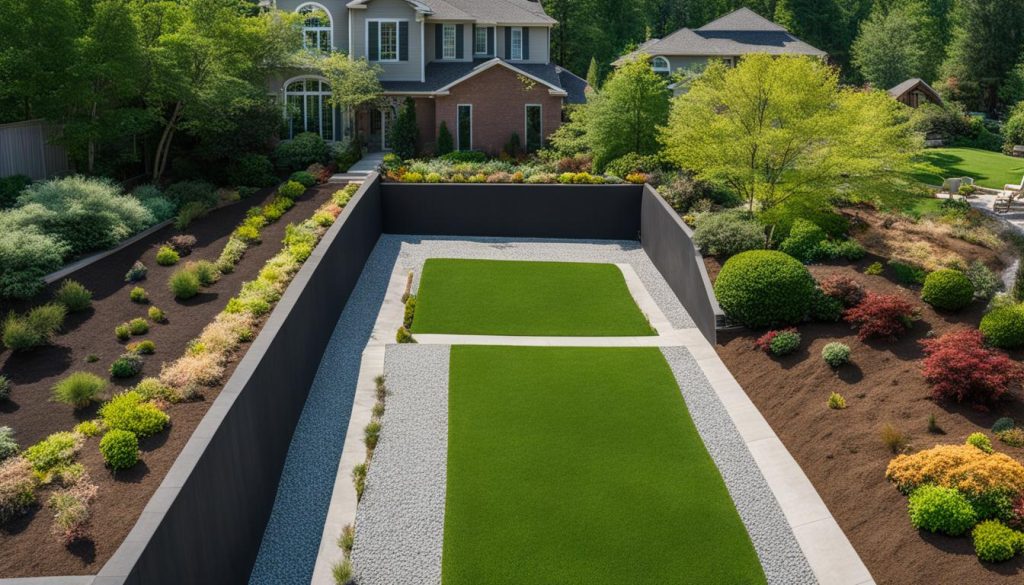Welcome to our article on retaining wall drainage solutions. At Retaining Wall Repair, we understand the importance of preventing water damage to properties. That’s why we offer affordable and efficient solutions to help homeowners protect their retaining walls from the destructive effects of water accumulation and soil erosion.
Retaining walls play a crucial role in supporting the surrounding soil and preventing landslides or erosion. However, without proper drainage systems, water can accumulate behind the wall and create pressure that can lead to structural damage and costly repairs. That’s why retaining wall drainage solutions are essential to maintaining the longevity and functionality of your retaining wall.
Our team of experts is here to help you find the right solution for your retaining wall drainage needs.
Key Takeaways:
- Retaining wall drainage solutions are crucial for preventing water damage and preserving the structural integrity of the wall.
- Common issues with retaining walls include water accumulation, excessive pressure, and soil erosion.
- Understanding retaining wall drainage and recognizing signs of poor drainage can help mitigate water damage.
- Professional installation and proper maintenance of drainage systems are essential for optimal performance and longevity.
- Choosing the right retaining wall drainage solution depends on factors like soil type, water flow patterns, and budget considerations.
Common Issues with Retaining Walls
At Retaining Wall Repair, we have seen a wide range of common issues that homeowners face with their retaining walls. Poor installation or lack of maintenance can result in costly damages to properties.
Water Accumulation
Excessive water accumulation is one of the primary issues with retaining walls. Without proper drainage systems, water can build up behind the wall, exerting excessive pressure on the structure and causing it to lean or collapse. Water can also seep through the soil and deteriorate the integrity of the wall over time. This can lead to significant structural damage and pose a risk to the safety of the surrounding area.
Excessive Pressure
Retaining walls are designed to withstand a significant amount of pressure from soil and water. However, excessive pressure can cause the wall to bow, crack, or lean, leading to significant structural issues. This can result from soil erosion, overloading, or inadequate drainage systems.
Soil Erosion
Soil erosion is another common issue that can lead to retaining wall failure. Without proper drainage, water can erode the soil behind the wall, causing it to collapse or lean. The loss of soil can also affect the wall’s stability, making it more susceptible to damage from pressure and other external factors.
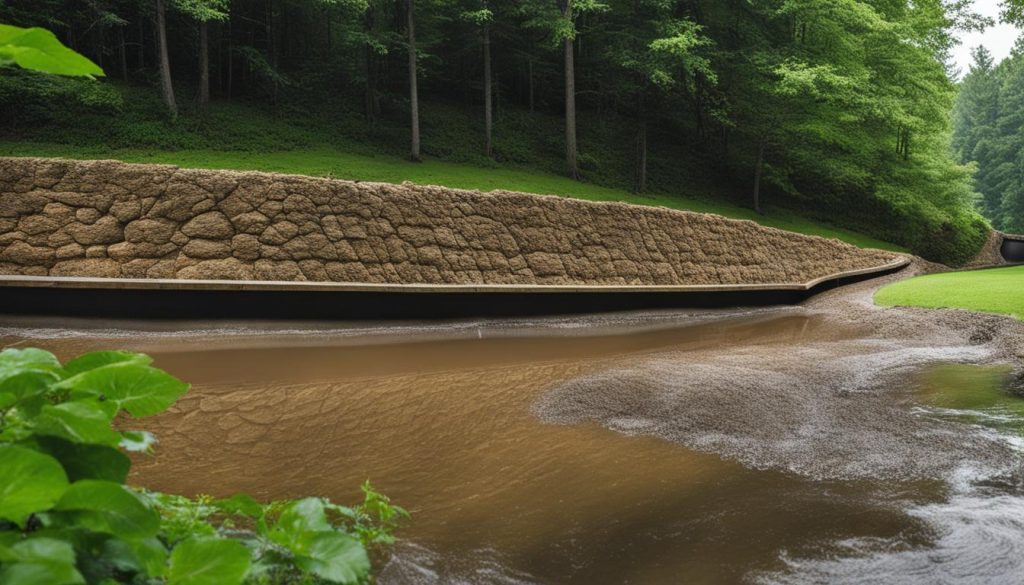
It is essential to address these common issues promptly to ensure your retaining wall remains stable and safe. Contact Retaining Wall Repair for efficient and cost-effective solutions to your retaining wall problems. We are committed to providing reliable retaining wall drainage solutions to our Canadian clients.
Understanding Retaining Wall Drainage
At Retaining Wall Repair, we understand that drainage is the key to a successful retaining wall. Proper drainage ensures that water flows away from the wall, reducing the risk of water damage and preserving its structural integrity. In this section, we’ll provide an overview of retaining wall drainage and its significance.
Retaining walls are designed to hold back soil and prevent erosion. However, without proper drainage, water can build up behind the wall, causing hydrostatic pressure and weakening its foundation. Over time, this can lead to structural damage, cracks, and bulges, which can be costly to repair.
Retaining wall drainage systems are designed to redirect water away from the wall and prevent water accumulation. There are several types of drainage solutions available, including French drains, weeping tiles, gravel backfills, and perforated pipes. The choice of drainage solution depends on the specific characteristics of the property and the retaining wall.
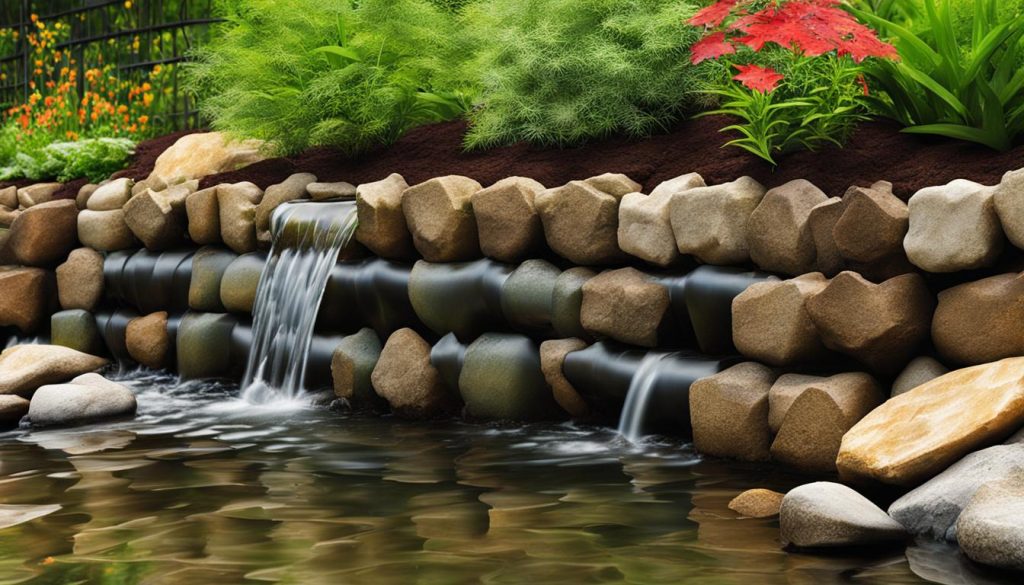
Proper installation of retaining wall drainage involves several key steps. The drainage system must be installed at the base of the wall and slope away from it, with a layer of geotextile fabric to prevent soil from clogging the system. The backfill material should also be selected carefully to ensure that water flows freely through it and away from the wall. Maintenance of the drainage system is also crucial to ensure its longevity and effectiveness.
At Retaining Wall Repair, we offer a range of professional retaining wall drainage solutions to help our Canadian clients protect their properties from water damage. Contact us at (647) 812-9837 or visit our website, https://www.retainingwallrepair.ca/, to learn more about how we can help you with your retaining wall drainage needs.
Importance of Retaining Wall Drainage Solutions
At Retaining Wall Repair, we understand the importance of investing in effective retaining wall drainage solutions. Not only do they help prevent water damage to your property, but they also ensure the longevity of your retaining wall, saving you from costly repairs or replacements in the future.
Retaining walls are subjected to various environmental factors that can compromise their structural integrity over time. Poor drainage is one of the most common issues faced by retaining walls, leading to water accumulation, excessive pressure, and soil erosion. These issues, if not addressed promptly, can cause significant damage to your property, including foundation issues, mold growth, and other health hazards.
That’s why we offer a range of affordable and efficient retaining wall drainage solutions tailored to your specific needs. Our team of experts carefully assesses your property and recommends the most suitable drainage system, such as French drains, weeping tiles, gravel backfills, or perforated pipes.
Benefits of Retaining Wall Drainage Solutions
| Benefits | Explanation |
|---|---|
| Prevent water damage | Effective drainage systems redirect water away from the wall, reducing the risk of water damage to your property. |
| Ensure longevity | Proper drainage systems help preserve the structural integrity of the wall, extending its lifespan and preventing costly repairs or replacements. |
| Cost-effective | Investing in reliable drainage solutions is more cost-effective than repairing or replacing a damaged retaining wall in the long run. |
Our team also ensures the proper installation of the drainage system, taking into account factors such as slope, backfill materials, and use of geotextiles. We use only high-quality materials to ensure optimal performance and longevity.
Furthermore, we provide tips and guidelines on how to maintain and monitor your retaining wall drainage system, including regular inspections, cleaning debris, and recognizing potential signs of system failure.
Signs of Poor Retaining Wall Drainage
Recognizing signs of poor retaining wall drainage is crucial for homeowners to prevent water damage to their properties. Here are some common indications that your retaining wall may have drainage issues:
- Water pooling: If you notice standing water around the base of the retaining wall or in the soil behind it, it could indicate a drainage problem.
- Dampness: Dampness or moisture on the wall’s surface or in the surrounding soil may indicate inadequate drainage.
- Mold growth: Mold or mildew growing on the wall or in the soil behind it can suggest poor drainage and excessive moisture.
- Cracks in the wall: Excessive pressure from water accumulation can cause cracks to form in the retaining wall, which can worsen over time without drainage solutions in place.
If you notice any of these signs, it’s important to take action promptly to avoid water damage and potential structural damage to your retaining wall.
Types of Retaining Wall Drainage Solutions
At Retaining Wall Repair, we provide various types of retaining wall drainage solutions tailored to meet your specific needs. Our expertise in drainage systems enables us to recommend and install the most suitable solution for your retaining wall to ensure optimal functionality and longevity. Below are some of the popular types of retaining wall drainage solutions we offer:
French Drains
A French drain is a popular type of retaining wall drainage solution that diverts water from the wall’s foundation to a more suitable location using a perforated pipe. This pipe is installed in a trench filled with gravel, which filters out any debris and ensures smooth water flow. French drains are versatile, affordable, and easy to maintain, making them an excellent option for various retaining wall types.
Weeping Tiles
Weeping tiles are another effective retaining wall drainage solution that creates a drainage path between the retaining wall and soil. The system involves installing a perforated pipe along the wall’s base and covering it with a layer of gravel, followed by a waterproofing membrane to prevent any water from penetrating the wall. Weeping tiles are ideal for areas with high water tables, heavy rainfall, or clay soils that hold water for extended periods.
Gravel Backfills
Gravel backfills are a simple yet effective retaining wall drainage solution that entails backfilling the space behind the retaining wall with gravel or other porous materials. This method provides a drainage path for water behind the wall, allowing it to move freely away from the wall and into the ground below. Gravel backfills are economical, environmentally friendly, and easy to install, making them an excellent choice for small retaining walls.
Perforated Pipes
Perforated pipes are a versatile and reliable retaining wall drainage solution that involves installing a perforated pipe along the base of the wall and connecting it to a drainage system that redirects water away from the wall. This solution is ideal for retaining walls made of non-porous materials, such as concrete or masonry, as it provides the necessary drainage while preserving the wall’s structural integrity. Perforated pipes are durable, low-maintenance, and highly effective, making them a popular choice among property owners.
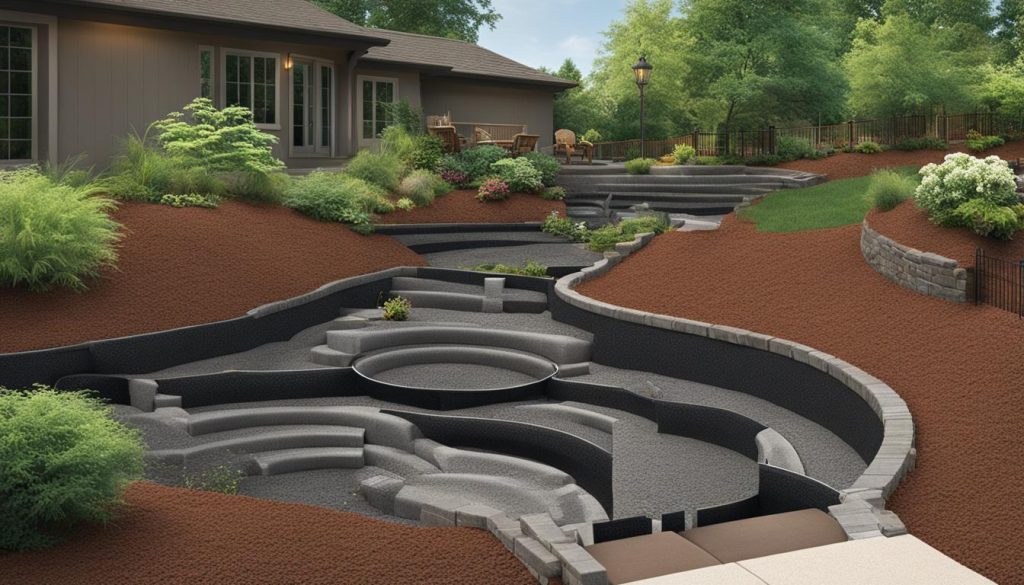
Contact Retaining Wall Repair to learn more about the best retaining wall drainage solution for your property. Whether you’re dealing with water accumulation or soil erosion, we have the expertise and experience to provide reliable and cost-effective solutions to protect your retaining wall from water damage.
Proper Installation of Retaining Wall Drainage Systems
Proper installation of retaining wall drainage systems is crucial for their optimal performance. Here are the key steps we follow to ensure our drainage systems meet the highest standards:
- Assess the site: Before installing the drainage system, we carefully evaluate the site’s characteristics, such as soil type, slope, and water flow patterns. This helps us design a custom drainage plan that addresses the property’s specific needs.
- Prepare the area: We clear the site of any debris or vegetation that could obstruct the drainage system. We also make sure the foundation is strong and stable before proceeding with installation.
- Create a channel: We dig a trench along the retaining wall’s base, deep enough to accommodate the drainage components. The trench’s width and depth depend on the type of drainage system used.
- Install the components: Depending on the drainage solution chosen, we may use perforated pipes, gravel backfill, weeping tiles, or a combination of these. We carefully place each component in the trench, ensuring that they fit snugly together and at the proper angle to facilitate water flow.
- Backfill and finish: Once the components are installed, we cover them with additional gravel or soil, depending on the design. We also compact the soil to prevent settling or erosion and finish the area with appropriate landscaping or hardscaping features.
Proper installation of retaining wall drainage systems significantly reduces the risk of water damage and ensures the wall’s longevity. We take pride in our expertise in this field and guarantee the quality and reliability of our work. Contact us to learn more about our professional services.
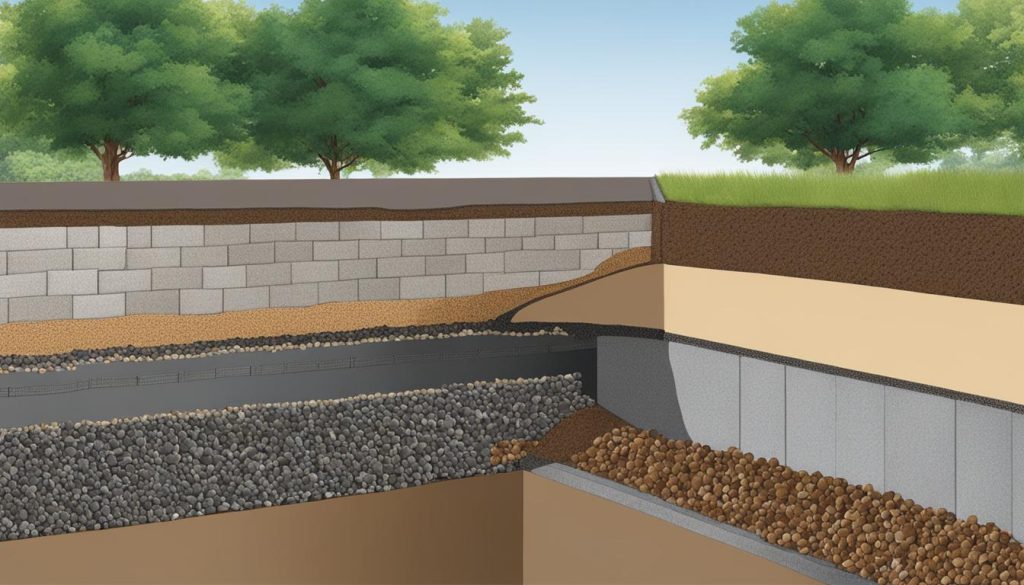
Maintaining Retaining Wall Drainage Systems
Proper maintenance of retaining wall drainage systems is crucial to ensure their longevity and continuous functionality. Neglecting their upkeep can lead to clogging, water accumulation, and potential damage to the wall structure, which may result in costly repairs or replacements.
Regular inspections: It’s essential to conduct periodic inspections of the drainage system to detect any signs of clogging, leakage, or damage. Inspect the system at least once a year or after heavy rainfalls. Check for any debris, leaves, or soil that may accumulate and obstruct the flow of water. If you notice water pooling or slow drainage, it may indicate a clogged or insufficient system.
Cleaning debris: One of the most common causes of inefficient drainage systems is the accumulation of debris. Remove any leaves, branches, or other organic matter that may accumulate near the wall or the drainage system. Use a garden hose or pressure washer to flush out any debris or dirt that may have clogged the pipes or weep holes.
Table: DIY vs. Professional Maintenance
| Maintenance Type | DIY | Professional |
|---|---|---|
| Frequency | 1-2 times a year | 1-2 times a year, or more, depending on the system’s complexity and size |
| Tools and Equipment | Garden hose, pressure washer, hand tools | Specialized tools, equipment, and machinery, such as drain snakes, power augers, or excavators |
| Cost | Low, but may vary depending on the complexity of the system and the necessary tools and materials | Higher, but guarantees efficient and reliable maintenance, without causing damage to the wall or surrounding property |
Professional maintenance: While DIY maintenance may be sufficient for small or straightforward systems, it’s advisable to hire a professional for larger, more complex drainage systems. Professionals have the skills, expertise, and specialized tools to identify and address potential issues before they escalate. Moreover, they can ensure the system’s proper installation, alignment, and slope, which are critical factors in maintaining optimal drainage performance.
If you notice any signs of system failure, such as dampness, odor, mold growth, or water infiltration in your property, contact Retaining Wall Repair immediately. Our expert team is equipped to handle any retaining wall drainage solutions and ensure your property remains safe and secure.
Professional Retaining Wall Drainage Solutions
At Retaining Wall Repair, we offer professional retaining wall drainage solutions tailored to meet the individual needs of your property. Our team of highly trained and experienced professionals is equipped with the latest technology and equipment to provide a comprehensive range of drainage solutions, including French drains, weeping tiles, and gravel backfills.
We understand that retaining wall drainage problems can be frustrating and potentially costly. That’s why we are committed to delivering fast, reliable, and cost-effective solutions that meet your budget and timeline. We work closely with our clients to ensure that the solutions we provide are tailored to their specific requirements and preferences.
Our services are designed to not only address existing drainage problems but also prevent future issues from occurring. We take a proactive approach to retaining wall maintenance and offer ongoing support and maintenance services to ensure that your retaining wall remains in optimal condition for years to come.
Our Process
Our process begins with a comprehensive assessment of your retaining wall’s drainage needs. We take into account factors like soil type, water flow patterns, and the overall condition of the wall to determine the most suitable drainage solution. We then work with you to develop a customized plan that meets your specific needs and preferences.
Our team of experts is trained to handle all aspects of retaining wall drainage, from initial installation to ongoing maintenance and repair. We use only the highest quality materials and equipment to ensure the longevity and reliability of our solutions.
Why Choose Us?
At Retaining Wall Repair, we pride ourselves on our commitment to delivering exceptional customer service and quality workmanship. Our team of experts has years of experience in providing affordable and effective retaining wall drainage solutions to homeowners and businesses across Canada.
We understand how important it is to have a retaining wall that is structurally sound and free from water damage. That’s why we are dedicated to providing cost-effective and reliable solutions that meet your unique needs and requirements.
Let us help you protect and preserve your property’s retaining wall for years to come.
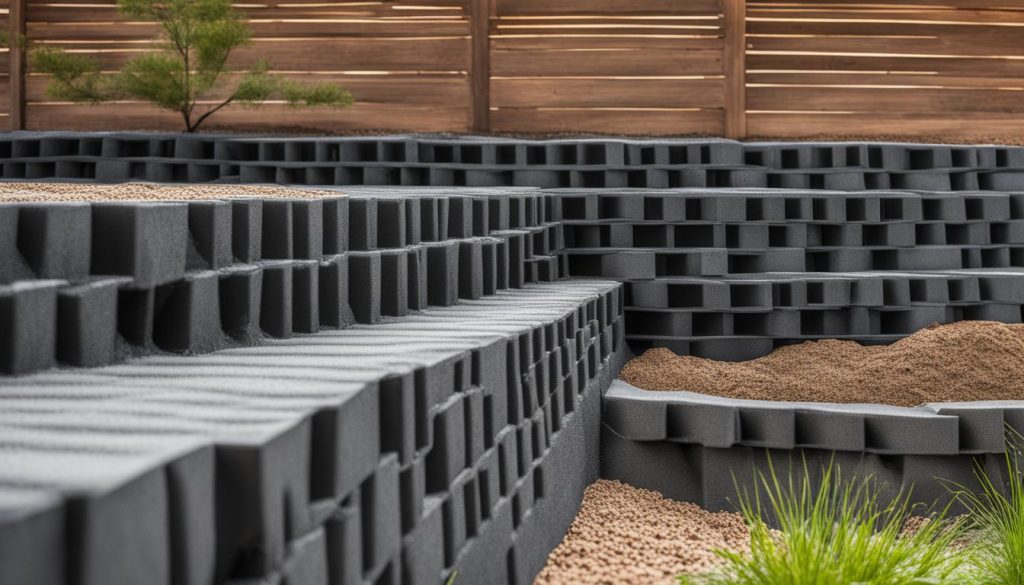
DIY Retaining Wall Drainage Solutions
Homeowners who are handy with tools and enjoy DIY projects can consider implementing small-scale retaining wall drainage solutions to avoid potential water damage to their properties. Here are some ideas:
French Drain
A French drain is a trench filled with gravel and a perforated pipe that redirects water away from the wall. This solution is suitable for properties with excess water accumulation. To install a French drain, follow these steps:
- Dig a trench along the base of the retaining wall.
- Place a layer of gravel at the bottom of the trench.
- Insert the perforated pipe into the trench.
- Fill the trench with gravel.
Ensure to slope the trench away from the wall for optimal water redirection.
Weeping Tile
A weeping tile is a perforated pipe that collects and drains water away from the retaining wall. This solution is suitable for properties with poor soil drainage. To install a weeping tile:
- Dig a trench along the base of the retaining wall.
- Place a layer of gravel at the bottom of the trench.
- Insert the perforated pipe into the trench.
- Align the pipe’s holes downwards.
- Fill the trench with gravel.
Make sure to slope the trench away from the wall and cover the pipe with landscape fabric to prevent clogging.
Gravel Backfill
Adding a layer of gravel behind the retaining wall can help promote proper drainage. To implement this solution:
- Clean the area behind the retaining wall.
- Insert a layer of gravel behind the wall.
- Spread a weed barrier on top of the gravel.
- Add another layer of soil on top of the weed barrier.
The gravel backfill will help redirect water away from the wall and prevent soil erosion and structural damage.
Perforated Pipes
Perforated pipes with geotextile fabric sleeves can also be used to promote drainage away from the retaining wall. To install perforated pipes:
- Insert the perforated pipes into the soil behind the retaining wall.
- Ensure to slope the pipes away from the wall.
- Wrap the pipes with geotextile fabric sleeves.
- Cover the pipes and sleeves with gravel or soil.
Perforated pipes are suitable for properties with high water tables and poor soil drainage.
It is important to keep in mind that while these DIY solutions may work for small-scale projects, larger retaining walls or severe water damage may require professional assistance. Contact us at Retaining Wall Repair for expert advice and assistance with your retaining wall drainage needs.
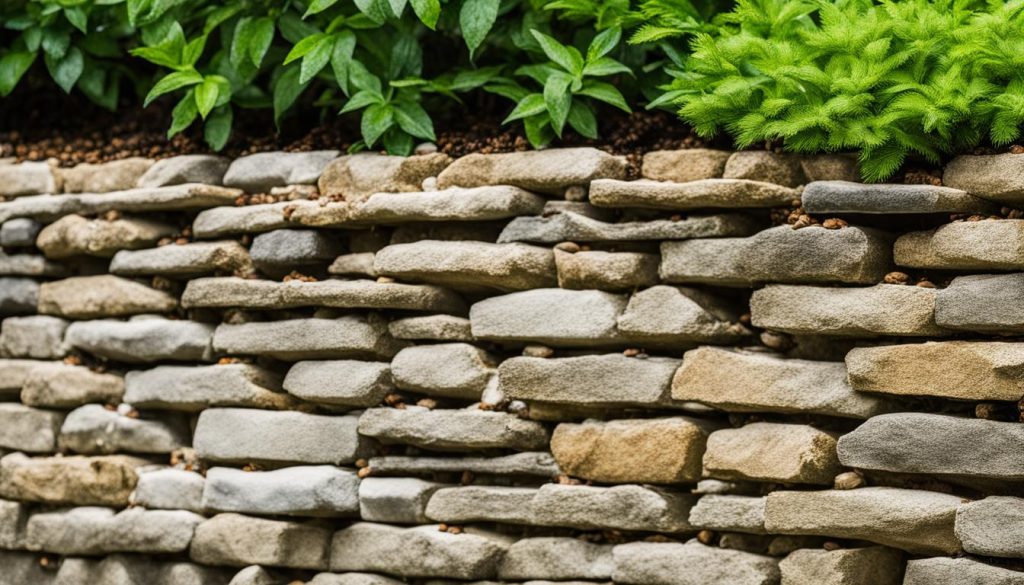
Choosing the Right Retaining Wall Drainage Solution for Your Property
When it comes to choosing the perfect retaining wall drainage solution for your property, there are several factors you need to consider. The right solution will depend on various factors like soil type, water flow patterns, and budget considerations. Below we have listed some of the essential factors that you must consider while selecting a retaining wall drainage solution for your property.
Soil type
The type of soil on your property is a crucial factor to consider when selecting a drainage solution. Different soil types have varying water absorption capabilities, which can affect the drainage system’s effectiveness. For instance, soils with high water absorption capabilities will require different drainage solutions compared to soils with limited water absorption capacities.
Water flow patterns
The water flow pattern on your property also plays a crucial role in selecting the right retaining wall drainage solution. Areas with higher water flow may require drainage solutions with the ability to handle more considerable water volumes effectively.
Budget consideration
Choosing the right drainage solution also depends on your budget. There are various retaining wall drainage solutions available, each with its installation and maintenance costs. You need to select a system that is within your budget while ensuring that it meets your property’s drainage needs.
Expert advice
Retaining wall drainage solutions can be complicated, and it’s always a good idea to consult an expert. Our team at Retaining Wall Repair has vast experience in providing reliable and effective drainage solutions. We can assess your property and recommend the most suitable drainage solution that fits your budget.
Choosing the right retaining wall drainage solution is essential for preserving the structural integrity of your retaining wall and preventing water damage. It’s crucial to consider soil type, water flow patterns, and budget considerations before making a final decision.
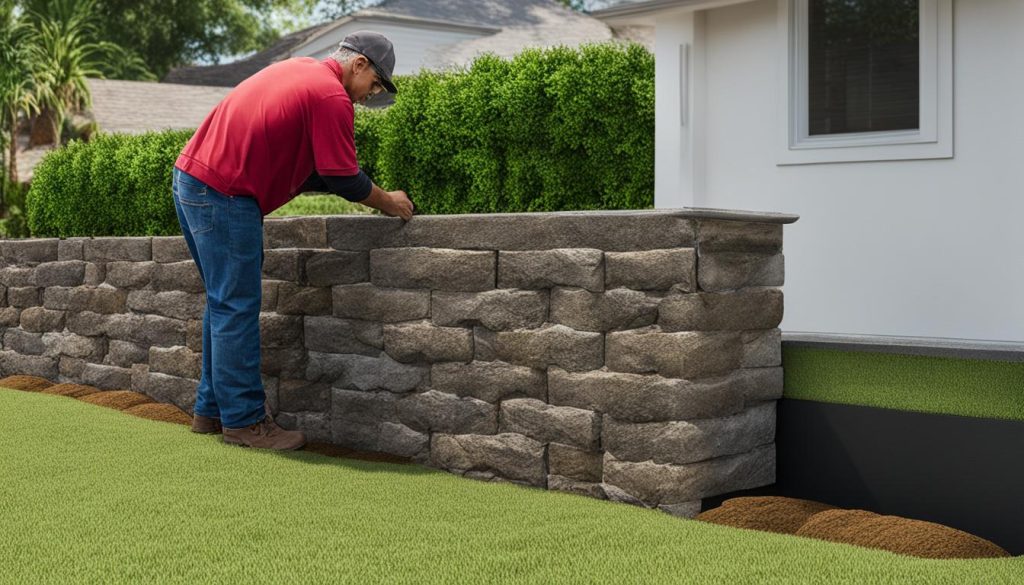
Contact Us for Expert Retaining Wall Drainage Solutions
At Retaining Wall Repair, we pride ourselves on providing our Canadian clients with top-notch retaining wall drainage solutions. If you’re experiencing poor drainage, water accumulation, or other issues with your retaining wall, we’re here to help.
Our team of experts has the knowledge, experience, and dedication necessary to deliver efficient and reliable solutions tailored to your specific needs. Whether you require French drains, weeping tiles, or gravel backfills, we have the tools and expertise to get the job done right.
Don’t let poor drainage compromise the structural integrity of your retaining wall. Contact us today at (647) 812-9837 or visit our website at https://www.retainingwallrepair.ca/ to schedule a consultation and learn how we can help you protect your property.
Remember, when it comes to retaining wall drainage solutions, we’ve got you covered.
FAQ
What are retaining wall drainage solutions?
Retaining wall drainage solutions are systems designed to redirect water away from the wall, preventing water damage and ensuring the longevity of the structure. These solutions help manage water accumulation, excessive pressure, and soil erosion.
Why is it important to prevent water damage to retaining walls?
Water damage can compromise the structural integrity of retaining walls, leading to costly repairs or replacements. By implementing effective drainage solutions, you can minimize the risk of water-related issues and preserve the longevity of your retaining walls.
How can I recognize poor retaining wall drainage?
Signs of poor retaining wall drainage include water pooling, dampness, mold growth, or cracks in the wall. If you notice any of these indications, it is advisable to address the drainage system promptly to prevent further damage.
What are the different types of retaining wall drainage solutions available?
Some common types of retaining wall drainage solutions include French drains, weeping tiles, gravel backfills, and perforated pipes. Each solution offers unique benefits and is suitable for specific requirements based on factors like soil type and water flow patterns.
How can I maintain my retaining wall drainage system?
To maintain your retaining wall drainage system, regular inspections and cleaning of debris are essential. It is also important to be vigilant for potential signs of system failure, such as water flow issues or blockages.
Why should I hire professionals for retaining wall drainage solutions?
Hiring professionals ensures that retaining wall drainage solutions are installed correctly and efficiently. Professionals have the expertise, experience, and knowledge of local regulations to provide reliable and cost-effective solutions for your retaining wall drainage needs.
Are there any DIY methods for small-scale retaining wall drainage solutions?
Yes, there are DIY methods that homeowners can consider for small-scale retaining wall drainage solutions. However, it is important to conduct proper research, consult with experts if needed, and adhere to local regulations to ensure the effectiveness and safety of the drainage system.
How do I choose the right retaining wall drainage solution for my property?
When selecting a retaining wall drainage solution for your property, consider factors such as soil type, water flow patterns, and budget considerations. Consulting with professionals can help you make an informed decision based on the specific needs and characteristics of your property.
How can I contact Retaining Wall Repair for expert retaining wall drainage solutions?
To get in touch with Retaining Wall Repair for expert retaining wall drainage solutions, you can call us at (647) 812-9837 or visit our website at https://www.retainingwallrepair.ca/. Our team of professionals is ready to assist you with all your drainage needs.

